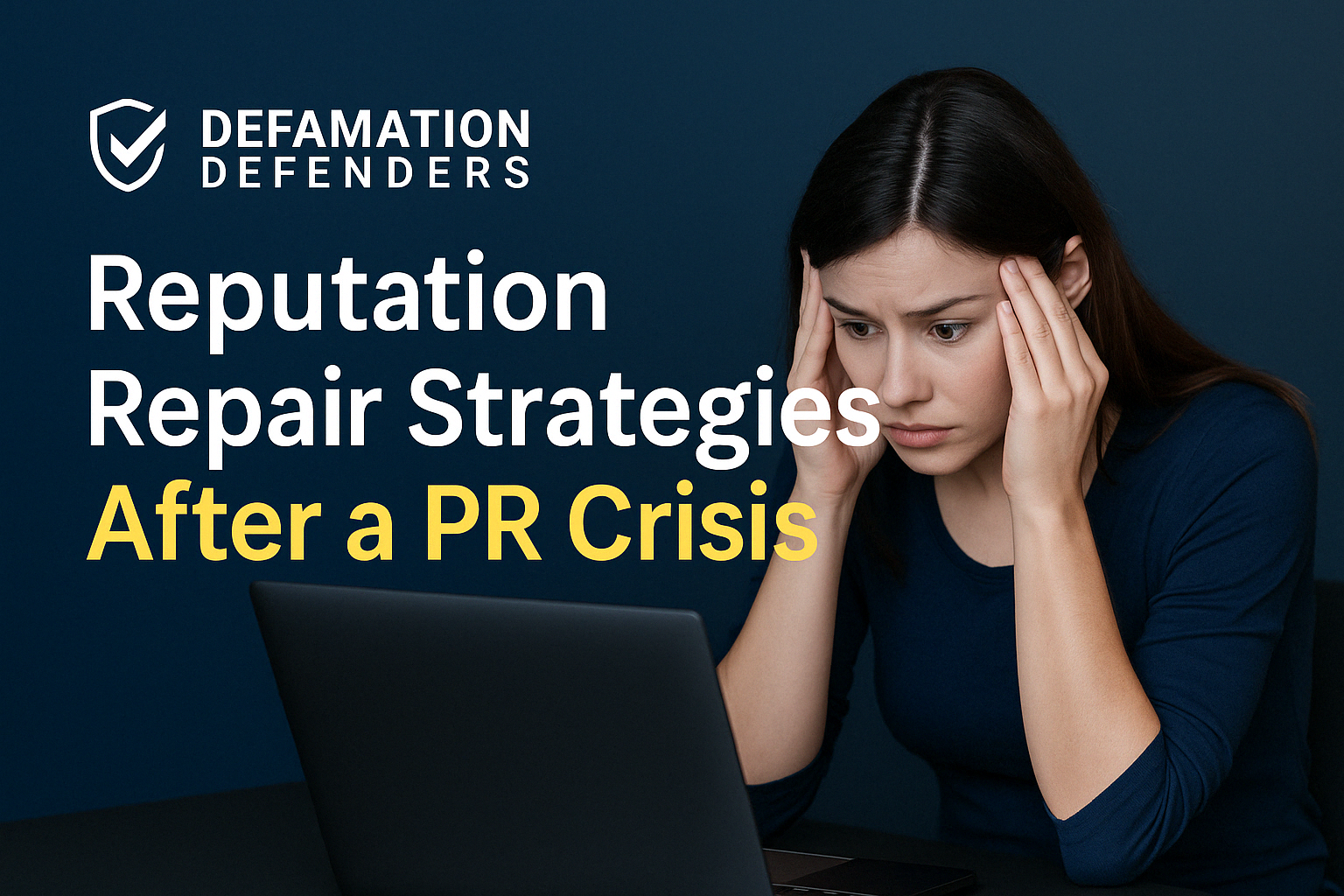Estimated reading time: 7 minutes
A PR crisis—be it a viral video, scandal, misinformation, or customer backlash—can break even the most established brands. Reputation repair is no longer optional; it’s critical. The way you respond in the hours, days, and months following a reputation blow determines whether your brand rebounds or becomes a cautionary tale.
This guide outlines proven, tactical approaches to restore trust and reestablish your reputation with long-term effectiveness.
Table Of Content
Understanding the Fallout of a PR Crisis
The impact can span:
- Loss of Consumer Trust
- Decline in Shareholder Confidence
- Reduced Sales and Revenue
- Employee Morale Issues
- Search Engine De-ranking
- Viral Negative Media Exposure
Immediate Response Framework
1. Assess the Damage
- Monitor mentions on Google, Reddit, social media, and news.
- Use tools like Mention or Google Alerts.
- Categorize the risk: Low, Medium, High.
2. Activate a Crisis Team
- Include PR, Legal, Executives, and SEO Experts.
3. Release a Public Statement
- Be transparent and empathetic.
- Avoid corporate-speak or over-apologizing.
“Transparency, when paired with accountability, becomes the strongest antidote to public distrust.”
Strategic Reputation Repair Methods
Strengthen Search Engine Presence
- Launch new blog posts and SEO-rich landing pages.
- Push positive press releases.
- Index YouTube videos and media profiles.
Online Review Management
- Respond to all reviews.
- Encourage loyal customers to leave fresh feedback.
Social Media Optimization
- Post community-driven updates.
- Respond calmly to criticism.
- Stay consistent across platforms.
Link-Building & PR
- Get featured in respected blogs or news.
- Collaborate with industry leaders.
- Contribute expert roundups or thought leadership.
Restore Trust Through Community Engagement
- Host town halls or community Q&As.
- Fund local nonprofits or scholarships.
- Share CSR wins and employee stories.
Monitor and Measure Recovery
Track:
- Search traffic and branded keywords
- Review sentiment trends
- Website bounce rate and time on site
- NPS and customer satisfaction
Legal Remediation (When Needed)
- Send cease-and-desist letters.
- Report content to platforms and search engines.
- Use Defamation Defenders to help file removals.
Further reading:
👉 How to Remove Negative News Articles from Google
Executive-Level Case Studies
United Airlines
Crisis: Viral video of passenger removal.
Fix: CEO apology, new policies, improved customer training.
Result: Reputation stabilized after 9 months.
Equifax
Crisis: Data breach affecting 140M people.
Fix: Free monitoring, C-suite changes, legal reform.
Result: Mixed public trust but retained industry position.
Internal Communication Strategy
- Host internal debriefs and updates.
- Create FAQ docs for employee reference.
- Offer 1:1 sessions for team morale.
Combatting Misinformation & Deepfakes
- Use Google Lens or TinEye for tracing content.
- File DMCA and impersonation reports.
- Engage fact-checkers and trusted media partners.
Influencer & Public Figure Recovery
- Archive risky past content.
- Issue one clear public statement.
- Lean into human stories: charity, family, learning.
- Appear on podcasts or live panels to reclaim your voice.
Crisis Playbook Template
Your team should build a reputation crisis playbook including:
- Roles and responsibilities
- Response timelines
- Pre-approved messaging
- External contact list
Run crisis simulations biannually to stay prepared.
Reputation Metrics That Matter
Quantitative
- Branded search traffic
- Review star averages
- Web traffic bounce rate
- Paid ad ROI
Qualitative
- Media sentiment
- Share of voice vs. competitors
- Stakeholder tone and confidence
Lessons from Global Brands
Starbucks
Crisis: Racial profiling incident.
Response: Closed stores for bias training.
Result: Widely praised recovery.
Apple
Crisis: Controversial right-to-repair stance.
Response: Increased transparency and developer engagement.
Result: Regained developer trust.
Regulatory Compliance After a Crisis
Consider:
- GDPR & CCPA breach notifications
- Transparent disclosures
- Internal compliance audits
Resources:
Brand Psychology in Reputation Repair
- Focus on emotional connection
- Reinforce shared values and integrity
“People don’t remember what you said, they remember how you made them feel.” — Maya Angelou
Multi-Channel Recovery Strategy
Owned Media
- Homepage refresh
- Blog narrative series
- Leadership Q&A
Earned Media
- Submit op-eds
- Participate in panels
- Share awards and partnerships
Paid Media
- Run ads targeting positive brand messaging
- Promote recovery stories in top search placements
Cybersecurity and Crisis Intersections
- Invest in breach response playbooks.
- Appoint a CISO (Chief Information Security Officer).
- Issue public updates about IT enhancements.
AI Tools for Faster Recovery
Use AI for:
- Sentiment analysis
- FAQ auto-responders
- Content generation (paired with human oversight)
Strategic Role of Reputation Insurance and Risk Management
More brands are integrating reputation insurance policies into their crisis preparedness plans.
Benefits of Reputation Insurance:
- Covers losses from reduced revenue post-crisis
- Funds media mitigation and PR recovery costs
- Offers immediate access to crisis communication consultants
Companies with strong risk management infrastructure bounce back faster because they budget for recovery before a crisis hits.
Building Resilience Through Stakeholder Relationships
Transparent communication with your internal and external stakeholders during a crisis fosters loyalty and softens reputational blowback.
Stakeholder Engagement Strategies:
- Schedule board and investor briefings with accurate timelines
- Open feedback channels for employees, vendors, and customers
- Regularly publish “State of Recovery” memos on your website or LinkedIn
Tip: Feature customer testimonials and partner quotes post-crisis to reinforce third-party credibility.
Using Thought Leadership as a Recovery Lever
Position your leaders as changemakers, not just crisis responders. A CEO or founder’s voice is powerful during recovery.
Platforms for Thought Leadership:
- TEDx or industry conferences
- Authoring books or whitepapers
- Participating in public roundtables and debates
Messaging Focus:
- What you’ve learned from the crisis
- Your roadmap for rebuilding trust
- Broader industry value or social good your brand supports
Technology Stack for Reputation Defense
Building a tech-enabled reputation recovery stack ensures fast, data-driven responses.
Tools to Consider:
- Brandwatch / Meltwater: for brand mention intelligence
- Onclusive / Cision: for PR performance tracking
- Reputation.com: for location-based review management
- SEMrush / Ahrefs: for negative search suppression analysis
- DataLossDB / HaveIBeenPwned: for cyber incident aftermaths
Cultural Sensitivity and Inclusive Messaging
Crises tied to discrimination, harassment, or cultural insensitivity require advanced reputation repair strategies.
Best Practices:
- Conduct third-party diversity audits
- Offer public commitments to equity with milestones
- Share hiring or vendor partnerships with underrepresented groups
Important: Tone-deaf or overly performative apologies often worsen crises—engage cultural experts to review all statements.
Ethical Considerations in Crisis Communications
Ethical choices influence long-term credibility.
Ethics Checklist:
- Is the messaging fact-based and not exaggerated?
- Does it acknowledge stakeholder pain without weaponizing guilt?
- Are you taking accountability or just avoiding blame?
Rule of thumb: Truth plus empathy, backed by timely action, builds reputational equity even amid crisis.
Post-Crisis Brand Narrative Reframing
Once operational stability is restored, shift focus from apology to aspiration.
Brand Storytelling Post-Crisis:
- Highlight resilience and rebirth
- Share behind-the-scenes decision-making
- Re-introduce brand mission with refined vision
Example tagline shift: Before: “Innovation at Scale” → After: “People First. Progress Always.”
Influencer and Partner Alignment Checks
After a crisis, audit existing influencers, affiliates, or brand partners:
Considerations:
- Have they posted anything contradictory to your brand values?
- Do they continue to engage with competitors exploiting your crisis?
- Can you co-create value-aligned content together?
Re-aligning your ecosystem ensures message consistency and shields your recovery from external contradictions.
When and How to Rebrand Post-Crisis
Sometimes, a reputation is too damaged to salvage. Rebranding may be the only viable option.
Signals That It’s Time to Rebrand:
- Your brand name becomes synonymous with scandal
- Google results remain negative after multiple campaigns
- Investor or public trust has irreparably collapsed
Rebranding Tactics:
- Launch with transparency: explain the why
- Retain your best people and culture elements
- Over-communicate to legacy customers and partners
Rebranding isn’t retreating—it’s rebooting with purpose.
Final Perspective: Crises as Catalysts
Handled wisely, a PR crisis becomes an opportunity for renewal. Brands like Tylenol, Domino’s, and Nike have turned mistakes into momentum.
The long-term reputation trajectory hinges not just on removing negative search results or appeasing critics—it depends on rebuilding emotional trust, refining operations, and telling better stories.
For customized strategies backed by legal protection and professional SEO expertise, connect with Defamation Defenders today.
Defamation Defenders: Your Reputation Partner
We provide:
- SEO suppression for harmful results
- PR recovery strategy development
- Review monitoring and response
- Full-service takedown and legal support
👉 Contact Defamation Defenders to start your custom reputation restoration plan.
FAQ
3–6 months for most campaigns, but some can take a year depending on severity.
Not always. But with suppression, it’s possible to push down damaging results.
Delay, silence, or over-apologizing without action.
Yes—by being transparent, reshaping their message, and engaging consistently.
Yes, especially for impersonation, false reporting, and malicious misinformation.
Related Contents:
Works Cited (MLA)
-
Coombs, W. Timothy. Ongoing Crisis Communication: Planning, Managing, and Responding. Sage, 2018.
-
Harvard Business Review. “How to Rebuild Your Reputation After a Crisis.” https://hbr.org/
-
Google. “Removing Information from Google.” https://support.google.com/websearch/answer/2744324
-
Institute for PR. “Crisis Management and Communications.” https://instituteforpr.org/crisis-management-communications/
-
FTC. “Social Media and Endorsements Guide.” https://www.ftc.gov
-
California Office of the Attorney General. “CCPA.” https://oag.ca.gov/privacy/ccpa
-
GDPR. https://gdpr.eu



